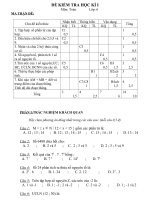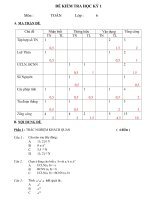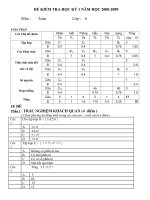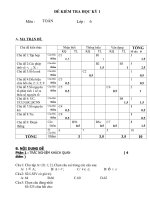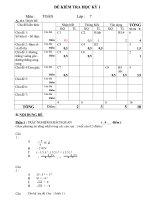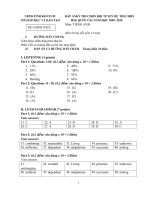click vào chữ read more để xem toàn bài và có thể download 1 bộ bài học internet marketing tiếng anh tuần 1 tuần 2 tuần 3 tuần 4 tuần 5 tuần 6 tuần 7 tuần 8 tuần 9 tuần 10 tuần 11 tuần 12 tuầ
Bạn đang xem bản rút gọn của tài liệu. Xem và tải ngay bản đầy đủ của tài liệu tại đây (88.08 KB, 14 trang )
<span class='text_page_counter'>(1)</span><div class='page_container' data-page=1>
Internet Marketing Concepts
</div>
<span class='text_page_counter'>(2)</span><div class='page_container' data-page=2>
Objectives
• The new communication medium
• The Internet and the marketing mix
• Key elements of effective web site designs
• Internet marketing versus conventional
</div>
<span class='text_page_counter'>(3)</span><div class='page_container' data-page=3>
The Internet as a New
Communication Medium
• Digital, interactive, and a greater depth of
information can be published
• Demographics may be different
</div>
<span class='text_page_counter'>(4)</span><div class='page_container' data-page=4>
The Digital Medium of the
Internet
• Predominantly a pull medium
• Enables interaction
• Potential for one-to-one or many-to-many
communication
• The medium changes the nature of
advertising
</div>
<span class='text_page_counter'>(5)</span><div class='page_container' data-page=5>
Communication Using the
Internet
Internet Medium
O
C
1C
5O
C
4C
2O
O
C
3O
Con
tent
M
C
on
ten
<sub>t</sub>
<sub>M</sub>
Co
nte
nt
M
Conte
<sub>nt</sub>
M
M
</div>
<span class='text_page_counter'>(6)</span><div class='page_container' data-page=6>
The Communication Model
N O I S E
Source
(web site)
Message encoding
Receiver
(web browser)
Message decoding
Site content or e-mail
</div>
<span class='text_page_counter'>(7)</span><div class='page_container' data-page=7>
Cultural Difference
• Uses of the Internet in the UK (1998) includes:
– Sending email (72 %)
– Research (63%)
– Education (58%)
– Seeking information on products and services (53%)
– Hobbies and interests (53%)
– Games playing (32%)
– Planning holidays (24%)
</div>
<span class='text_page_counter'>(8)</span><div class='page_container' data-page=8>
In Europe and the USA
• Average age of user is 35.7 years old
• 38.5 % female and 61.5% male (22%, 72%
Europe)
• 65% access the Web from home (29% Europe)
• Average household income $53,000
</div>
<span class='text_page_counter'>(9)</span><div class='page_container' data-page=9>
Cultural Difference
• Techno_lusters – focused in the culture and technology
• Academic buffs – originally on of the main types of users
• Techno-boffins – similar to the techno-lusters, but make more directed
use of the technology for business
• Get aheads – use the Internet as a lifestyle accessory, use email and
Internet for product selection
• Hobbyists – people with specialist interests who use the Internet for
purchase selection (golfers…)
• Knowledge traders – business oriented users who turn to the Internet
for news services and information on best business practice
• Business bods – general business users in management roles
</div>
<span class='text_page_counter'>(10)</span><div class='page_container' data-page=10>
Internet and Marketing Mix
<b>Product</b>
• Quality
• Image
• Branding
• Features
• Variants
• Mix
• Support
• Customer
service
• Use
occasion
• Availability
• Warranties
Using the Internet to vary the marketing mix
<b>Price</b>
• Positioning
• List
• Discounts
• Credit
• Payment
methods
• Free or
value-added
elements
<b>Promotion</b>
• Marketing
communica
tions
• Personal
promotion
• Sales
promotion
• PR
• Branding
• Direct
marketing
<b>Processes</b>
• Customer
focus
•
Business-led
•
IT-supported
• Design
features
• Research
and
developme
nt
<b>People</b>
• Individuals
on
marketing
activities
• Individuals
on customer
contact
• Recruitment
• Culture/ima
ge
</div>
<span class='text_page_counter'>(11)</span><div class='page_container' data-page=11>
The buying Process on the Internet
Stages in
buying process Communications<sub>objectives</sub>
Internet marketing
techniques
1. Unaware
2. Aware of
product need,
develop
specification
3. Suppliers
search
4. Evaluate and
select
5. Purchase
6. Post-purchase
Generate awareness
Lead generation
(from range of
customers)
Assist
purchase
decision
Facilitate purchase
Position Features,
benefits and brands
Banner advertising,
PR, links
Web site content
(Plus search support)
Search engines,
Intermediaries
Web site content,
Intermediaries
Web site content
</div>
<span class='text_page_counter'>(12)</span><div class='page_container' data-page=12>
Key Elements of Effective Web Site
Design
• Capture
• Content
• Community
• Commerce
</div>
<span class='text_page_counter'>(13)</span><div class='page_container' data-page=13>
Alternative Factors
• Attract users
• Engage users’ interest and participation
• Retain users and ensure that they return to
the site
• Learn about customer preference
</div>
<span class='text_page_counter'>(14)</span><div class='page_container' data-page=14>
Internet Marketing vs
Conventional Marketing
• It is a many-to-many medium
• Consumers can interact with the medium
• Consumers can provide commercially
</div>
<!--links-->
